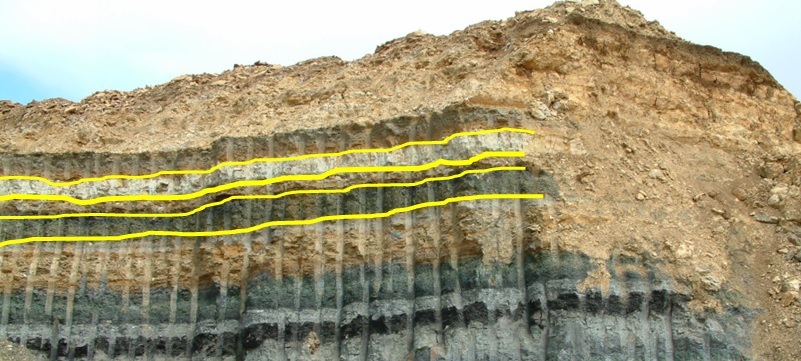The focus for this earth cache is to introduce the logger to the concept of stratigraphy and link this to observations made on the rock wall at GZ.
Áherslan á þessa jarðskjálfti er hugtakið stratigraphy. Þessar hugmyndir verða notaðar til að útskýra athuganirnar sem gerðar eru á bergvegginum við GZ.

Example of stratigraphy where the four top most stratigraphic layers are mapped.

Stratigraphy is a geology discipline concerned with the description of rock successions and their interpretation in terms of a general time scale. It provides a basis for historical geology. It is primarily used in the study of sedimentary and layered volcanic rocks. Variation in rock units, most obviously displayed as visible layering, is due to physical characteristics of the rock type called lithology. This variation can occur vertically as layering, or laterally, and reflects changes in environments of deposition. Key concepts in stratigraphy involve understanding how certain geometric relationships between rock layers arise and what these geometries imply about their original depositional environment.
The basic concept in stratigraphy, called the law of superposition, states: in an undeformed stratigraphic sequence, the oldest strata occur at the base of the sequence.
The small mountain to your South-East with the rock wall facing the ocean is named Valahnukur mountain. The mountain was formed in one single eruption and shows evidence of two different phases of eruption and the subsequently creation of two distinct layers with two distinct lithologies.
One layer consists of tuff, that is a rock of hardened volcanic ash. Tuff is formed when airborne volcanic ash settles in water and consolidates. The tuff at GZ is composed of volcanic glass which is formed by very rapid cooling, hence no crystals had time to form.
The other layer is made of basaltic pillow lava. Pillow lavas are submarine lava flows where the individual pillows are coated by a thin shell of volcanic glass which forms due to the rapid cooling when the lava hits the ambient water. The cooling restricts the lava flow to pillow sizes. The lava then squeezes out in between the pillows and a new pillow is coated with glass. The result is a formation of a heap of pillow lavas as seen on the rock wall in front of you.
To log this earth cache you must test your understanding of the concept of stratigraphy and terms like lithology and the law of superposition.
 BRIEF VERSION
BRIEF VERSION
Stratigraphy er geology aga notað til að lýsa tíma lína fyrir myndun steina. Það veitir grundvöll fyrir sögulegu jarðfræði. Það veitir grundvöll fyrir sögulegu jarðfræði. Það er fyrst og fremst notað í rannsókn á seti steina og hraun. Variation í rokkareiningum sem sýnilegt lag, er vegna líkamlegra eiginleika bergsins. Þessi lýsing er kallað lithology. Þessar sveiflur geta átt sér stað lóðrétt eða láréttum og endurspeglar breytingar í umhverfi af úrkomu.
Grunnhugtökin í stratigraphy, sem kallast 'superposition' lögin, segir: í ósniðnu stratigrafískri röð eru elstu lagarnir í botn röðarinnar.
Til að skrá þig inn í þetta geocache verður þú að prófa skilning þinn á hugmyndinni um stratigraphy og hugtök eins og litology og 'superposition' lögmálið.
____________________________
Please email me any suggestions for improvements, corrections or additions to the text of this cache.
Vinsamlegast sendu mér tölvupóst á nokkrar tillögur um úrbætur, leiðréttingar eða viðbætur við texta þessa skyndiminni.
Send the answers by e-mail via the cache owner's profile page on Geocaching.com. You can log immediately after you have emailed me your answers. Sendu svörin með tölvupósti. Þú getur skráð þig strax eftir að þú hefur sent mér svörin þín.
Logs without answers emailed to CO or with pending questions from CO will be deleted without any further notice. Logs án svör sem sendar eru til CO verður eytt án frekari tilkynningar.
Walk to GZ and answer the following questions/Ganga til GZ og svaraðu eftirfarandi spurningum
Spurningar/Questions:
- Based on the law of superposition: Which part of the rock was first formed – the top most or the bottom most rock ? . Byggt á lögum um ofbeldi: Hvaða hluti af klettinum var fyrst myndað - efsta mest eða neðst mest rokk?
- How would you characterize the lithology (texture, color) if the upper most part of the rock? Is this tuff or pillow lava ? Hvernig myndir þú einkenna lithology ef efri hluti steinsins? Er þetta tuff eða koddi hraun?
- How would you characterize the lithology if the bottom part of the rock wall? Is this tuff or pillow lava ? Hvernig myndir þú einkenna lithology ef botnhlutinn af klettamúrnum? Er þetta tuff eða koddi hraun?
- Take a picture of your or your GPS or something that identify your nick at GZ without revealing any of the answers to the questions above. Taka mynd af þinni eða GPS þínum á vefsvæðinu án þess að sýna fram á svörin við spurningunum hér að ofan.
Sources:
Poster at GZ and Wikipedia